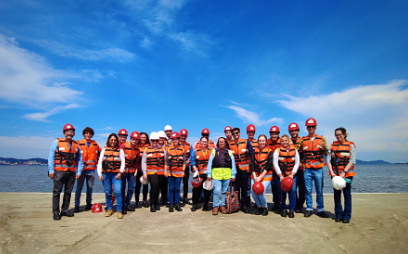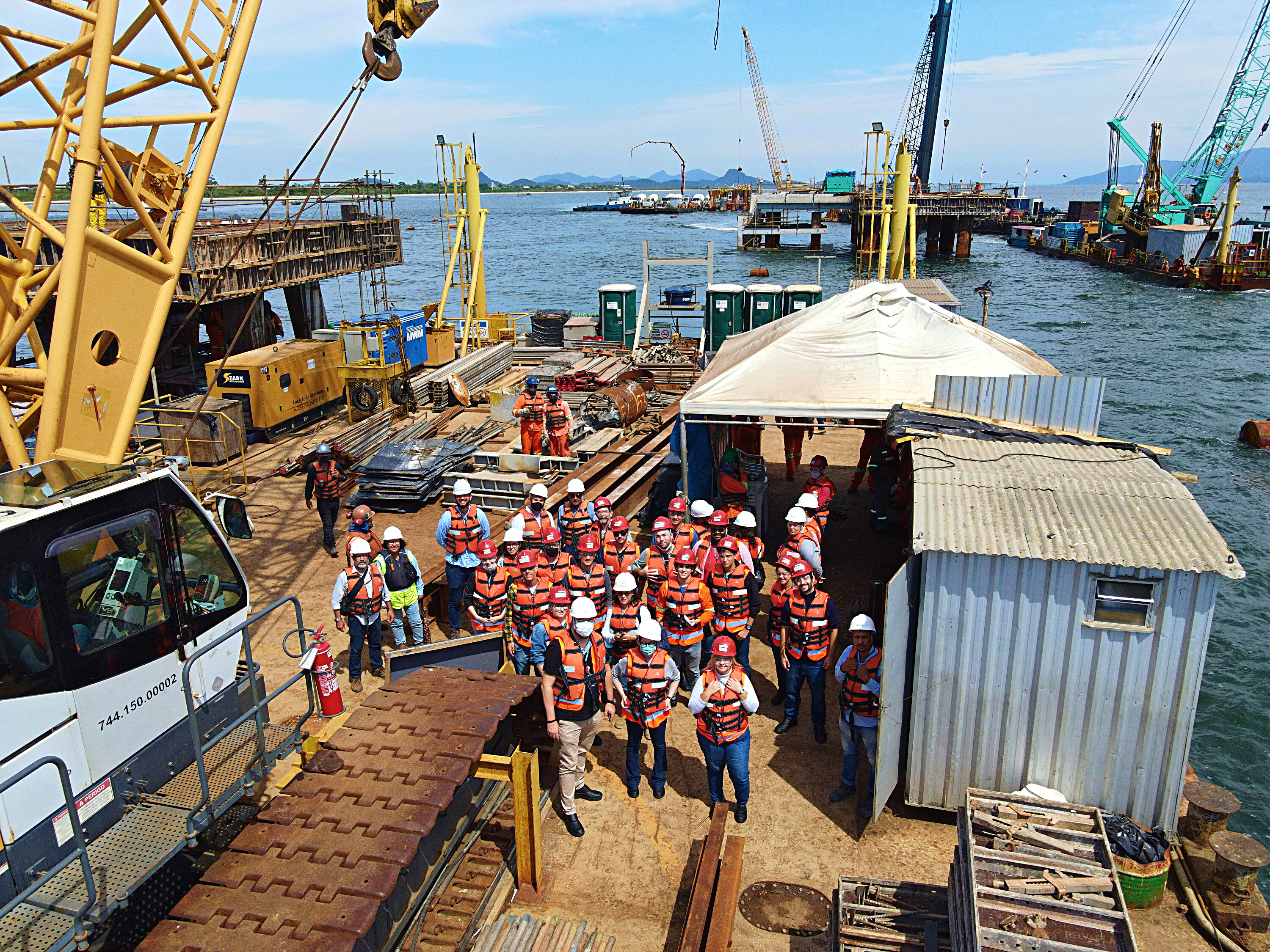As construction at the Gávea subway station advances to the stage involving the detonation of 60 meters of rock,...
UFSC students visit the South Gas Terminal construction site
DATE: 04/08/2022

A class of 15 students from the Civil Engineering program from the Florianópolis campus of the Federal University of Santa Catarina visited the construction site of the South Gas Terminal (TGS), in the Babitonga Bay (SC), on March 30. The visit is part of the community relations program organized by the construction management team. A new group of students, this time from the Federal Technological University of Paraná (UTFPR), is already scheduled to visit the undertaking in April.
The students had the opportunity to see, in loco, one of the most relevant works in progress in the State of Santa Catarina. The first part of the technical visit was the offshore works. On board one of the six ferries that make up the project’s logistics system, baptized “Perpetuar”, the students were able to observe several activities, such as the concreting of one of the project’s maritime structures, composed of two docking dolphins, four mooring dolphins, and an operational platform, where the Terminal’s equipment for gas unloading, which will be operated remotely, will be located. These structures are supported by 85 one-meter diameter steel piles manufactured in lengths ranging from 48 to 57 meters, and laid at depths of up to 30 meters below the seabed.

On the day of the visit it was possible to observe the complex logistical operation for the transportation of the ready-mix concrete that sails for 18 km to reach the construction site at sea. As explained by Engineer Ricardo Corregio, the manager responsible for the offshore works, the concrete barge, as it is called, transports up to eight concrete mixer trucks with 64 cubic meters of concrete and weighs about 300 tons. Taking into consideration that navigation alone takes approximately two hours, it was necessary to develop a special concrete mix for the project that is valid for 10 hours, with the need for refined coordination of logistics so that the interval between the machining and application is as short as possible, taking into account unforeseen events such as eventual weather variations that may alter sea conditions. The civil works for the marine terminal, which began in October 2021, are scheduled for completion in April 2022.
Directional bore
The second stage of the visit promoted the appreciation of Horizontal Directional Drilling (HDD), the directional hole that will connect the onshore and offshore pipeline. The HDD is being executed by partner company Siecapag-Intech, owned by the French VINCI group. Compared to the traditional trenching model, the HDD methodology presents considerable advantages, such as less impact on the execution and occupation of spaces, low interference in the sea environment, less navigation impact (Babitonga Bay is the base of operation of two ports), besides making the work faster and more efficient. The directional drilling takes place in three stages: the first consists of drilling the pilot hole, when during drilling a sensor is installed in the drill bit to ensure georeferenced navigation, as determined in the project. In the next stage, after the pilot hole has been drilled, the drill bit is replaced with reamers that increase the diameter of the hole until it reaches one and a half times the diameter of the pipeline to be installed. The last phase is the pipeline installation, when the pullback is made and the welded pipeline column is pulled into the hole.
According to Engineer Paulo Jorge Fernandes, the manager responsible for the onshore works, HDD is a very efficient technology. “It provides less environmental impact for installing gas pipelines at river crossings, highway crossings, and when interconnecting marine facilities with land pipelines. This was the rationale for us to opt for this methodology”, he says.
According to UFSC professor Marcos Aurélio Marques Noronha, coordinator of the group of students, this was the best visit ever made by the students under his guidance. “A chance like this, where you have the opportunity to see in practice subjects such as concreting, pile driving, rock excavation, land and sea works, crane operation, among others, is worth more than an entire engineering program”, he enthusiastically evaluated.
Currently, the construction work generates more than a thousand direct jobs and has reached the important mark of 250 thousand person-hours worked without accidents.
THE TGS
The venture will supply 15 million cubic meters of Natural Gas per day, representing a more than three times the total currently available in the State of Santa Catarina. The Terminal is located 300 meters off the coast of the city of São Francisco do Sul, and includes infrastructure to receive, store, regasify, and distribute natural gas that will arrive in the form of LNG (Liquefied Natural Gas) by sea through methane carriers and will be transferred by the ship to ship system to a FSRU (floating storage and regasification unit) with a capacity to store 160 thousand cubic meters of LNG, which, in turn, will be interconnected by 33 km of 20-inch pipelines with GASBOL



No comments